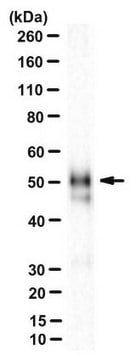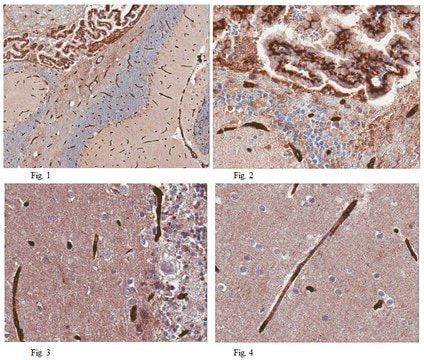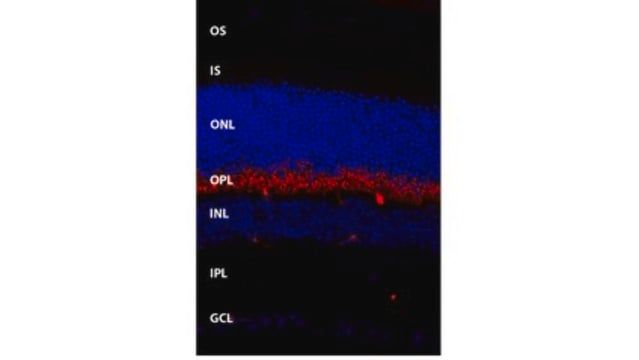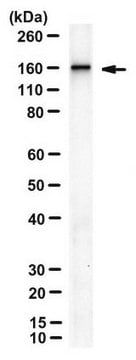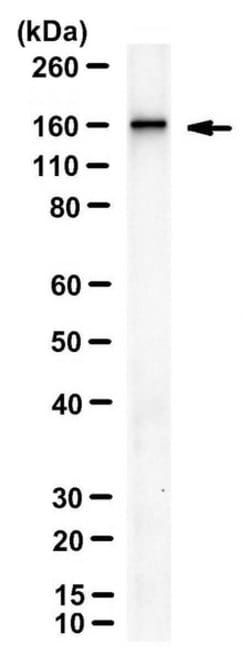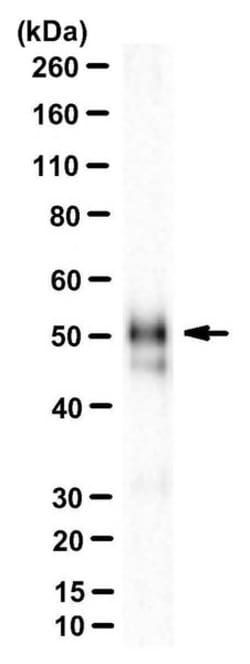MABS1917
Anti-RIP140 Antibody, clone 6D7
clone 6D7, from mouse
Manufacturer: Sigma Aldrich
Synonym(S): Nuclear receptor-interacting protein 1, Nuclear factor RIP140, Receptor-interacting protein 140
Select a Size
| Pack Size | SKU | Availability | Price |
|---|---|---|---|
| 100 μG | MABS1917-100-μG | In Stock | ₹ 36,880.00 |
MABS1917 - 100 μG
In Stock
Quantity
1
Base Price: ₹ 36,880.00
GST (18%): ₹ 6,638.40
Total Price: ₹ 43,518.40
biological source
mouse
Quality Level
100
antibody form
purified immunoglobulin
antibody product type
primary antibodies
clone
6D7, monoclonal
species reactivity
human, mouse, rat
packaging
antibody small pack of 25 μg
technique(s)
ChIP: suitablewestern blot: suitable
isotype
IgG1κ
NCBI accession no.
NP_003480.2
Description
- General description: Nuclear receptor-interacting protein 1 (UniProt: P48552; also known as Nuclear factor RIP140, Receptor-interacting protein 140) is encoded by the NRIP1 gene (Gene ID: 8204) in human. RIP140 is a nuclear protein that is localized to discrete foci and redistributes to larger nuclear domains upon binding to ligand-bound NR3C1. It is expressed in liver in a circadian manner. RIP140 contains 9 Leu-Xaa-Xaa-Leu-Leu (LXXLL) motifs, which have different affinities for nuclear receptors. The C-terminal LTKTNPILYYMLQK motif is required for ligand-dependent interaction with retinoic acid (RA) receptor-alpha (RARA) and retinoid X receptor beta (RXRB) homodimers and heterodimers, for the corepressor activity, and for the formation of an HDAC3 complex with RARA/RXRB. It also contains at least four autonomous repression domains (RD1-4). RD1 functions via a histone deacetylase (HDAC)-independent mechanism, whereas RD2, RD3 and RD4 can function by HDAC-dependent or independent mechanisms, depending on cell type. RIP140 Acetylation regulates its nuclear translocation and co-repressive activity of RIP140 is regulated by its acetylation, which is shown to abolish its interaction with C-terminal-binding protein 1 (CTBP1). Several glucocorticoid responses are shown to be deregulated by RIP140 possibly via an interaction between the glucocorticoid receptor (GR), which prevents binding of true co-activator with GR. (Ref.: Subramaniam N, et al. (1999). J. Biol. Chem. 274(25):18121-7).
- Specificity: Clone 6D7 detects Nuclear receptor-interacting protein 1 (RIP140) in human, mouse, and rat cells. It targets an epitope with in 178 amino acids from the N-terminal half.
- Immunogen: GST-tagged recombinant fragment corresponding to 178 amino acids from the N-terminal half of human Nuclear receptor-interacting protein 1 (RIP140).
- Application: Anti-RIP140, clone 6D7, Cat. No. MABS1917, is a mouse monocloanl antibody that detects RIP140 and has been tested for use in Chromatin Immunoprecipitation (ChIP) and Western Blotting.
- Quality: Evaluated by Western Blotting in MCF7 cell lysate.Western Blotting Analysis: 1 µg/mL of this antibody detected RIP140 in 10 µg of MCF7 cell lysate.
- Target description: ~160 kDa observed; 126.94 kDa calculated. Uncharacterized bands may be observed in some lysate(s).
- Physical form: Format: Purified
- Storage and Stability: Stable for 1 year at 2-8°C from date of receipt.
- Other Notes: Concentration: Please refer to lot specific datasheet.
- Disclaimer: Unless otherwise stated in our catalog or other company documentation accompanying the product(s), our products are intended for research use only and are not to be used for any other purpose, which includes but is not limited to, unauthorized commercial uses, in vitro diagnostic uses, ex vivo or in vivo therapeutic uses or any type of consumption or application to humans or animals.
SAFETY INFORMATION
WGK
WGK 1
Compare Similar Items
Show Difference
biological source: mouse
Quality Level: 100
antibody form: purified immunoglobulin
antibody product type: primary antibodies
clone: 6D7, monoclonal
species reactivity: human, mouse, rat
packaging: antibody small pack of 25 μg
technique(s): ChIP: suitablewestern blot: suitable
isotype: IgG1κ
NCBI accession no.: NP_003480.2
biological source:
mouse
Quality Level:
100
antibody form:
purified immunoglobulin
antibody product type:
primary antibodies
clone:
6D7, monoclonal
species reactivity:
human, mouse, rat
packaging:
antibody small pack of 25 μg
technique(s):
ChIP: suitablewestern blot: suitable
isotype:
IgG1κ
NCBI accession no.:
NP_003480.2
biological source: mouse
Quality Level: 100
antibody form: purified immunoglobulin
antibody product type: primary antibodies
clone: 6F1-H5, monoclonal
species reactivity: mouse
packaging: antibody small pack of 25 μg
technique(s): ChIP: suitablewestern blot: suitable
isotype: IgG2aκ
NCBI accession no.: __
biological source:
mouse
Quality Level:
100
antibody form:
purified immunoglobulin
antibody product type:
primary antibodies
clone:
6F1-H5, monoclonal
species reactivity:
mouse
packaging:
antibody small pack of 25 μg
technique(s):
ChIP: suitablewestern blot: suitable
isotype:
IgG2aκ
NCBI accession no.:
__
